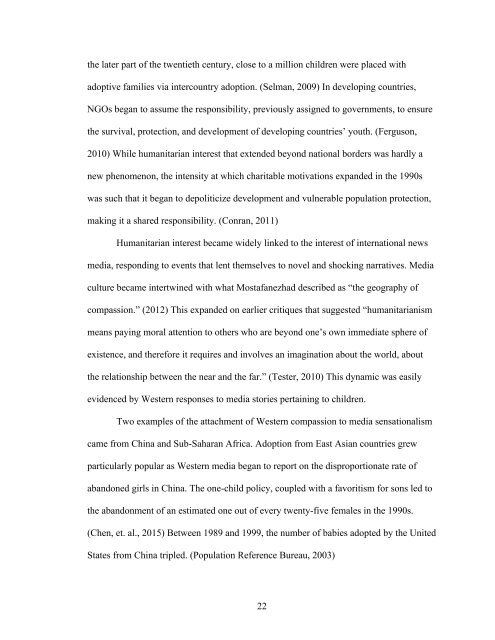INSTITUTIONALIZED CHILD CARE IN URBAN SOUTH AFRICA
Create successful ePaper yourself
Turn your PDF publications into a flip-book with our unique Google optimized e-Paper software.
the later part of the twentieth century, close to a million children were placed with<br />
adoptive families via intercountry adoption. (Selman, 2009) In developing countries,<br />
NGOs began to assume the responsibility, previously assigned to governments, to ensure<br />
the survival, protection, and development of developing countries’ youth. (Ferguson,<br />
2010) While humanitarian interest that extended beyond national borders was hardly a<br />
new phenomenon, the intensity at which charitable motivations expanded in the 1990s<br />
was such that it began to depoliticize development and vulnerable population protection,<br />
making it a shared responsibility. (Conran, 2011)<br />
Humanitarian interest became widely linked to the interest of international news<br />
media, responding to events that lent themselves to novel and shocking narratives. Media<br />
culture became intertwined with what Mostafanezhad described as “the geography of<br />
compassion.” (2012) This expanded on earlier critiques that suggested “humanitarianism<br />
means paying moral attention to others who are beyond one’s own immediate sphere of<br />
existence, and therefore it requires and involves an imagination about the world, about<br />
the relationship between the near and the far.” (Tester, 2010) This dynamic was easily<br />
evidenced by Western responses to media stories pertaining to children.<br />
Two examples of the attachment of Western compassion to media sensationalism<br />
came from China and Sub-Saharan Africa. Adoption from East Asian countries grew<br />
particularly popular as Western media began to report on the disproportionate rate of<br />
abandoned girls in China. The one-child policy, coupled with a favoritism for sons led to<br />
the abandonment of an estimated one out of every twenty-five females in the 1990s.<br />
(Chen, et. al., 2015) Between 1989 and 1999, the number of babies adopted by the United<br />
States from China tripled. (Population Reference Bureau, 2003)<br />
22


